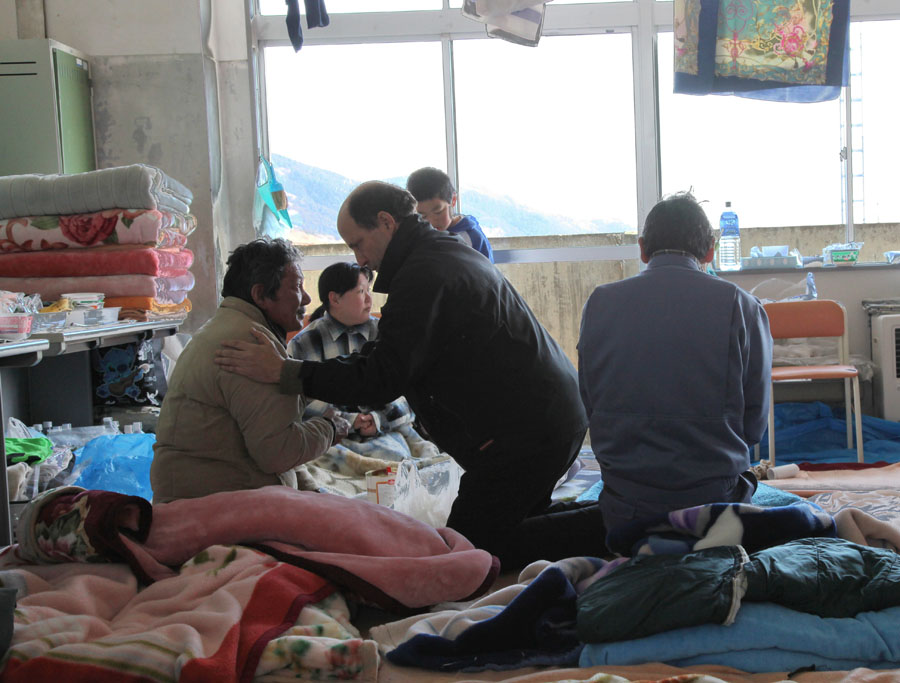悲しいニュースや原発や救援の遅々たる進行などが毎日続くと気が滅入る。
現場の人達は必死だろうが、周辺住民、周辺都県の住民の緊張もかなりなものになってきているのではないか?
ウニ半値、マダイ3割安…高級魚値崩れ築地悲鳴
おお? 貧乏人のおいらには朗報。しこたまいただくか?
Fear of Spreading Radiation in Japan
Potential radioactive steam from Fukushima plant poses hazard.
03/22/2011
22日のABCだが、築地などにいって魚などガイガーカウンターを当てて調べている。全く問題なし。
ウッシッシ。

Expat in Japan: ‘We are preparing for the worst and hoping for the best'
By Leah Hyslop 4:37PM GMT 23 Mar 2011
東京に家族とともに残ったイギリス人を紹介している。
最悪の状況にそなえながらも最善の方向を望んでいる、と。
正しい、態度だと思う。
いっしょに頑張っていきましょう。

地殻の破壊、茨城県沖で止まった…その理由は?
なるほど。

孫SB社長と佐賀・武雄市長「雇用や食事1年間保証」福島・田村市
2011.3.23

なぜか、二人ともはげ。これで、はげの株が上がった(?)・・・なことは関係ない。
お二人とも立派。
高橋洋一の民主党ウォッチ
原子力安全・保安院の問題体質 経産省「植民地」、そして「東電の虜」
2011/3/24
今後、日本をダメにしている政官民の一部癒着関係を徹底的に追求しなければ、日本は、そして、国民・住民は、救われない。
マスコミのみなさんの出番です。
Japanese geisha, 85, vows to continue performing in tsunami-hit home town
Chikano Fujima, who lost home in disaster, says she will stay in Kamaishi to help keep tradition alive
Justin McCurry in Osaka
85才の岩手で被災した芸者さんを 豪州人芸者のSayukiさんが福井の友人の家を紹介して援助。
心温まる話だが、記者のマッカリ氏、大阪にいるのが何とも・・・・
'Whale Wars' activist survives quake
By Patrick Oppmann, CNN
March 19, 2011
シーシェパード命からがら帰国
途中日本人から援助を受ける。
まったく関係ないが、くせで、
23 March 2011 Last updated at 17:47 GMT Share this pageFacebookTwitterShareEmailPrint
Women 'trafficked' to work as prostitutes, court hears
Up to 70 women may have been brought to the UK and Ireland to work as prostitutes, a Belfast court has heard.
北アイルランド
人身売買・売春
現場の人達は必死だろうが、周辺住民、周辺都県の住民の緊張もかなりなものになってきているのではないか?
ウニ半値、マダイ3割安…高級魚値崩れ築地悲鳴
市場内でホテルやレストラン向けに魚をさばく業者も開店休業状態が続く。需要減少を受け、一部の高級魚介などは価格が下落し、一時、ウニは半値に。赤エビ、ボタンエビ、天然マダイやヒラメ、キンメダイなどは2、3割程度値下がりしたという。都中央卸売市場築地市場水産農産品課は「ホテルの婚礼や宴会の中止、すし店の消費の減少などの影響」と分析する。
(2011年3月24日10時04分 読売新聞)
おお? 貧乏人のおいらには朗報。しこたまいただくか?
Fear of Spreading Radiation in Japan
Potential radioactive steam from Fukushima plant poses hazard.
03/22/2011
22日のABCだが、築地などにいって魚などガイガーカウンターを当てて調べている。全く問題なし。
ウッシッシ。

Expat in Japan: ‘We are preparing for the worst and hoping for the best'
By Leah Hyslop 4:37PM GMT 23 Mar 2011
東京に家族とともに残ったイギリス人を紹介している。
最悪の状況にそなえながらも最善の方向を望んでいる、と。
正しい、態度だと思う。
いっしょに頑張っていきましょう。

地殻の破壊、茨城県沖で止まった…その理由は?
余震の発生領域の南限がフィリピン海プレートの北東端に一致していることが判明。同プレートの北東端が、地殻破壊の房総半島沖への南下を食い止めたとみている。
なるほど。

孫SB社長と佐賀・武雄市長「雇用や食事1年間保証」福島・田村市
2011.3.23

Here's my statement & a photo from my visit to Ishinomaki. I hope you retweet this far & wide so everyone understands. http://goo.gl/SllM2
100+人がリツイート
AmbassadorRoos
John V. Roos
なぜか、二人ともはげ。これで、はげの株が上がった(?)・・・なことは関係ない。
お二人とも立派。
高橋洋一の民主党ウォッチ
原子力安全・保安院の問題体質 経産省「植民地」、そして「東電の虜」
2011/3/24
規制する側が規制される側に取り込まれて、規制が規制される側に都合よく歪曲されるメカニズムを「Regulatory Capture」(規制の虜)という。東電の虜になった政府は、国民に対して「由(よ)らしむべし、知らしむべからず」の姿勢で原子力行政を行い、今回そのツケが最悪の形で回ってきたのだ。
日本にとって深刻なのは、今の原発事故のみならず、経産省原子力安全・保安院と東電のようなもたれ合い関係が政府の至る所にあることだ
今後、日本をダメにしている政官民の一部癒着関係を徹底的に追求しなければ、日本は、そして、国民・住民は、救われない。
マスコミのみなさんの出番です。
Japanese geisha, 85, vows to continue performing in tsunami-hit home town
Chikano Fujima, who lost home in disaster, says she will stay in Kamaishi to help keep tradition alive
Justin McCurry in Osaka
85才の岩手で被災した芸者さんを 豪州人芸者のSayukiさんが福井の友人の家を紹介して援助。
心温まる話だが、記者のマッカリ氏、大阪にいるのが何とも・・・・
'Whale Wars' activist survives quake
By Patrick Oppmann, CNN
March 19, 2011
シーシェパード命からがら帰国
途中日本人から援助を受ける。
まったく関係ないが、くせで、
23 March 2011 Last updated at 17:47 GMT Share this pageFacebookTwitterShareEmailPrint
Women 'trafficked' to work as prostitutes, court hears
Up to 70 women may have been brought to the UK and Ireland to work as prostitutes, a Belfast court has heard.
The details emerged as a restaurant owner was remanded in custody charged with two counts of controlling prostitution for gain.
北アイルランド
人身売買・売春










